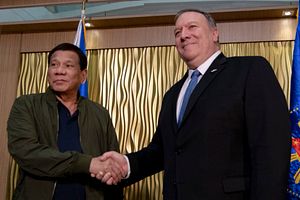The South China Sea is heating up once again. This time, tensions are rising between China and the Philippines, with echoes of their 2012 stand-off over the Scarborough Shoal. However, unlike then, the Philippine leadership – specifically President Rodrigo Duterte – has, for some time, been expressing favour towards Beijing.
The current crisis concerns the Philippines’ most significant military outpost in the Spratly group – in waters that China claims under its capacious nine-dash line that covers nearly 90 per cent of the South China Sea.
These vessels encompass the gamut of Chinese capabilities, including so-called “maritime militia” vessels – commercial ships tasked with asserting Beijing’s interests. In recent years, China also has supported the operation of these vessels with warships and maritime law enforcement vessels.
One-to-one, the Philippine Navy is hopelessly outmatched against China. The large number of vessels around Thitu Island not only has deterred Philippine fishermen from entering waters that an international tribunal in 2016 deemed to rightfully belong to Manila’s continental shelf, but also restricts the movement of the country’s military vessels.
Moreover, China’s militarization of Mischief Reef and six other natural features in the Spratlys over the past five years has sealed in a permanent presence threatening Manila’s capabilities.
The tribunal ruling that was meant to bring down the full force of international law in the Philippines’ favour regarding maritime entitlement claims fell flat as China carried on ignoring the award and a change in government in Manila allowed relations between the two countries to enter a new phase under Duterte.
Beijing’s push in the Spratlys, however, comes not long after the United States offered an important clarification to Manila on the scope of the countries’ mutual defence treaty.
For years, Philippine officials had expressed frustration over Washington’s reluctance to unequivocally clarify whether an attack by a third party on disputed features administered by the Philippines in the South China Sea would fall under the treaty’s collective defence provision.
Last month, US Secretary of State Mike Pompeo offered that clarification for the first time. The two countries have been treaty allies since August 30, 1951, making Manila Washington’s oldest formal ally in the eastern hemisphere to receive security assurances.
“China’s island building and military activities in the South China Sea threaten [Philippine] sovereignty, security and therefore economic livelihood, as well as that of the United States,” Pompeo said last month in Manila.
“As the South China Sea is part of the Pacific, any armed attack on Philippine forces, aircraft or public vessels in the South China Sea will trigger mutual defence obligations under Article 4 of our mutual defence treaty,” he said.
Apart from pushing back on Manila’s efforts to maintain and improve Thitu Island, China appears to be testing the limits of the U.S.-Philippine alliance – perhaps intending to elicit statements from Duterte that once again show deference to China and lash out at the United States.
However, that hasn’t quite happened. Somewhat uncharacteristically, Duterte pushed back on Beijing this time, warning: “If you touch [Thitu Island] … I will tell my soldiers [to] ‘prepare for suicide missions’.”
The Philippine president’s new-found vigour in pushing back against China in Manila’s exclusive economic zone will be welcome, but it remains to be seen if it will have staying power.
The country is gearing up for elections next month and, while Duterte won’t be on the ballot, voters effectively will be expressing their sentiments about his administration. Philippine sovereignty in the South China Sea remains an emotive issue and Duterte’s posturing may be motivated by these considerations.
Even so, China may have overplayed its hand with Duterte this time. With the recent assurance offered by the United States – bolstered by the recent start of the ongoing U.S.-Philippine Balikatan exercises – Manila and Washington may find themselves truly standing shoulder to shoulder.
This article first appeared in the South China Morning Post. It is republished here with kind permission.
































